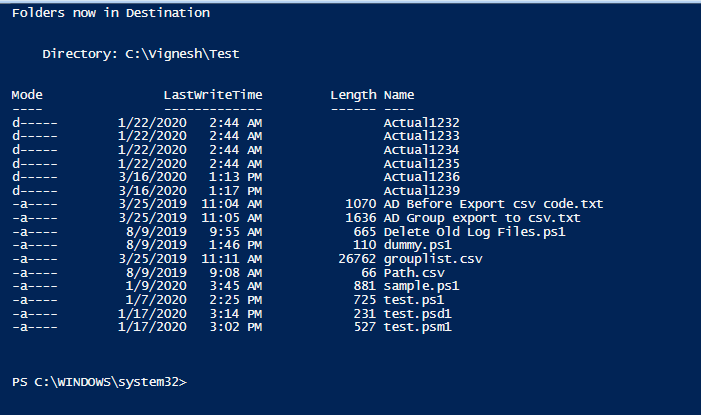

The article also demonstrated appropriate example scripts on how to rename a single file, single folder, multiple files, multiple folders and how a file name can be appended with today date. It can be used to rename folders, files or any item. Thus, the article covered in detail about the Rename-Item cmdlet. Get-ChildItem C:\Vignesh\Test -Recurse | Rename-Item -NewName

Write-Host "before renaming the folders names are as below" Write-Host "Renaming multiple folders at once" Write-host "Welcome to the demo of bulk renaming of folders and files" Rename-Item -Path C:\Vignesh\Test\Test9\test.txt -NewNameactual.txt Get-ChildItem -Path C:\Vignesh\Test\Actual1239 Write-Host "List of folders after renaming" Write-Host "Renaming completed successfully"

Rename-Item -Path C:\Vignesh\Test\Test1 -NewName Test9 Write-Host "List of Folders before renaming" Write-host "Renaming Test1 to test9 in the below example" Write-Host "Welcome to the demo of renaming folder" List of Providers in the current PowerShell Session Nameįollowing are the example are given below: Example #1 To find the list of available providers in our session, run the below cmdlet. The rename-item cmdlet supports only with providers that are being exposed. Its default value is false.It doesn’t accept pipeline characters as input and wild card characters are also not accepted. It just shows what will happen if the cmdlet is run. WhatIf: This doesn’t produce any output.Pipeline input is accepted whereas wild card characters are not considered. It denotes the path of the item to be renamed. It is used to return items to be the pipeline. PassThru: This doesn’t generate any input.It accepts pipeline input, but wild card characters are not accepted. Replace operator must be used when multiple items are to be renamed. The cmdlet will understand whether a path or a file must be renamed. Only a name must be entered and not a path. -NewName: This denotes the new name of the item to which the item must be renamed.In case if the path contains escape characters, it must be enclosed within single quotation to inform PowerShell not to interpret as escape sequence.

None of the characters are interpreted as wild cards. The value whatever is typed as the literal value.


 0 kommentar(er)
0 kommentar(er)
